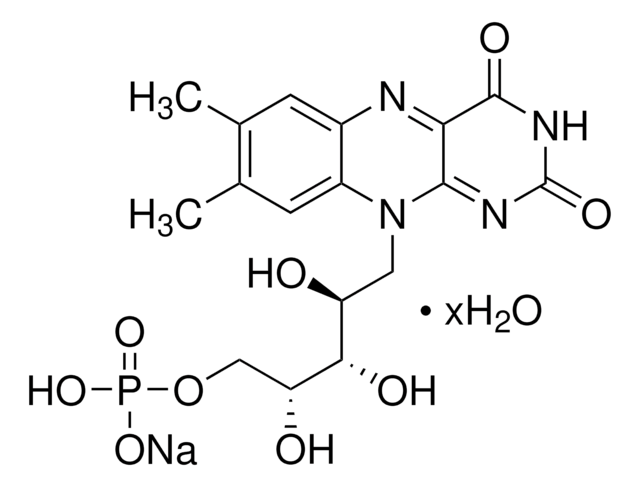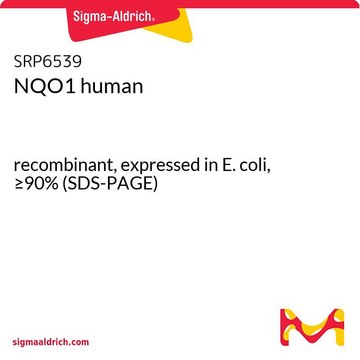F1392
Riboflavin 5′-monophosphate sodium salt hydrate
suitable for electrophoresis, suitable for acrylamide photopolymerization, ≥70%, powder
Sinonimo/i:
FMN-Na, Flavin mononucleotide, Riboflavin 5′-phosphate sodium salt
About This Item
Prodotti consigliati
Livello qualitativo
Saggio
≥70%
Forma fisica
powder
Attività ottica
[α]20/D +37 to +42°, c = 1.5 in 5 M HCl(lit.)
tecniche
electrophoresis: suitable
Solubilità
H2O: soluble 50 mg/mL, clear, orange
ε (coefficiente d’estinzione)
12.5 at 445 nm at 1 mM
Compatibilità
suitable for acrylamide photopolymerization
Attività estranea
Protease, none detected
Temperatura di conservazione
−20°C
Stringa SMILE
O.[Na+].Cc1cc2N=C3C(=O)NC(=O)N=C3N(C[C@H](O)[C@H](O)[C@H](O)COP(O)([O-])=O)c2cc1C
InChI
1S/C17H21N4O9P.Na.H2O/c1-7-3-9-10(4-8(7)2)21(15-13(18-9)16(25)20-17(26)19-15)5-11(22)14(24)12(23)6-30-31(27,28)29;;/h3-4,11-12,14,22-24H,5-6H2,1-2H3,(H,20,25,26)(H2,27,28,29);;1H2/q;+1;/p-1/t11-,12+,14-;;/m0../s1
BHRVCJBIICJWTH-APQIITSESA-M
Cerchi prodotti simili? Visita Guida al confronto tra prodotti
Applicazioni
- to study its mechanism of inhibition of mutagenicity of a benzo[a]pyrene 7,8-diol 9,10-epoxide, a carcinogenic metabolite of benzo[a]pyrene
- along with flavin adenine dinucleotide for reactivation of the enzyme that catalyzes the oxidation of pyridoxamine to pyridoxal in a study
- to study the reduction of polymeric azo and nitro dyes by intestinal bacteria
- to study the effect of FMN on ferrisiderophore reductase activity in the cytoplasmic fraction of Agrobacterium tumefaciens.
Azioni biochim/fisiol
FMN is suitable as a photopolymerization reagent in polyacrylamide gel electrophoresis (PAGE) by forming free radicals in aqueous solution in the presence of light. FMN photodecomposes to leucoflavin. No free radicals are formed in the absence of oxygen, but traces of oxygen allow for leucoflavin to reoxidize with free-radical generation. The catalysts, tetramethylethylenediamine (TEMED) or 3-dimethylaminopropionitrile (DMAPN), are commonly added to speed up the free radical formation. Free radicals will cause acrylamide and bis-acrylamide to polymerize to form a gel matrix which can be used for sieving macromolecules. FMN is commonly used in the stacking gel for non-denaturing PAGE because native proteins can be sensitive to persulfate ions from ammonium persulfate. Another advantage of FMN over ammonium persulfate is that it will not start polymerizing until the gel is illuminated.
Codice della classe di stoccaggio
11 - Combustible Solids
Classe di pericolosità dell'acqua (WGK)
WGK 1
Punto d’infiammabilità (°F)
Not applicable
Punto d’infiammabilità (°C)
Not applicable
Dispositivi di protezione individuale
Eyeshields, Gloves, type N95 (US)
Certificati d'analisi (COA)
Cerca il Certificati d'analisi (COA) digitando il numero di lotto/batch corrispondente. I numeri di lotto o di batch sono stampati sull'etichetta dei prodotti dopo la parola ‘Lotto’ o ‘Batch’.
Possiedi già questo prodotto?
I documenti relativi ai prodotti acquistati recentemente sono disponibili nell’Archivio dei documenti.
I clienti hanno visto anche
Il team dei nostri ricercatori vanta grande esperienza in tutte le aree della ricerca quali Life Science, scienza dei materiali, sintesi chimica, cromatografia, discipline analitiche, ecc..
Contatta l'Assistenza Tecnica.




